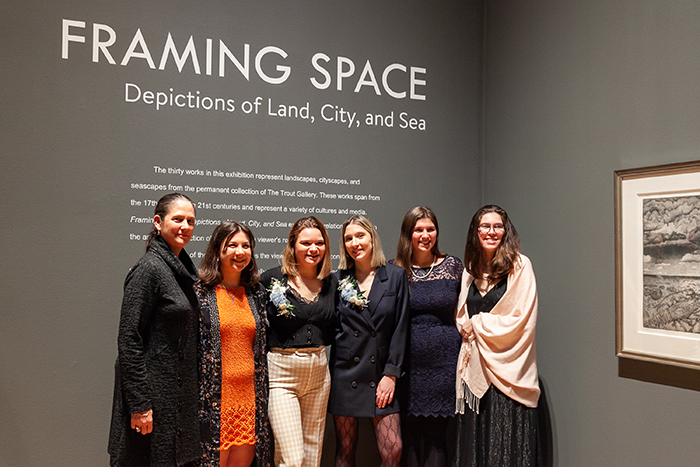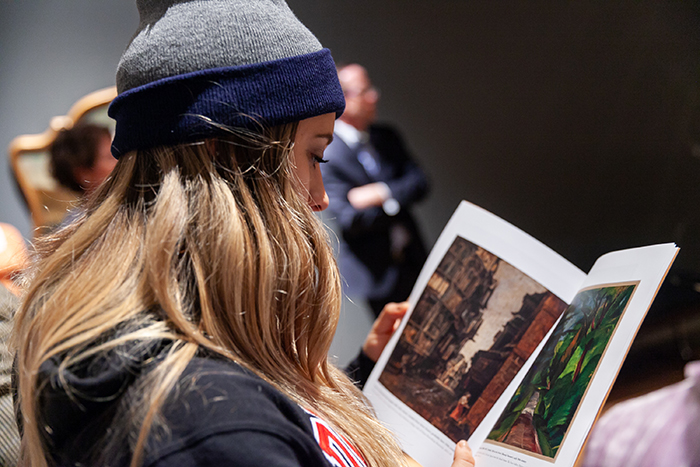By Land and By Sea: Art History Capstone Exhibition Highlights Four Centuries of Landscapes, Seascapes and Cityscapes

Students attend the opening for the student-curated exhibition Framing Space. Photo by Carl Socolow '77.
Exhibition examines renderings of outdoor spaces across continents and over centuries
For centuries, artists have sought to memorialize the beauty and magnitude of the great outdoors. One exhibition, now showing at Dickinson’s Trout Gallery, digs deep into the gallery’s permanent collection to present exceptional representations of outdoor spaces viewed from across the globe and across eras.
The exhibition, Framing Space: Depictions of Land, City, and Sea, opened Feb. 28, and remains on exhibition at The Trout Gallery through April 1. It was curated by senior art-history majors Kaila Basile, Ashlyn Buffum, Bizz Fretty, Hannah King and Natura Sant Foster, in fulfillment of their senior seminar.

Five student-curators pose with Professor of Art History Melinda Schlitt (far left) during the Feb. 28 opening reception. Photo by Carl Socolow '77.
The students selected 30 works from The Trout Gallery’s collection, some of which had never before been exhibited at Dickinson. Then they researched the works and designed the exhibition and the accompanying catalogue, which includes their original scholarship.
The oldest work is Figures Fishing by a Resting Stream, circa 1650, an oil painting created by a follower of master Dutch landscape painter Jacob van Ruisdael. The newest, Wise Tree (2015), is an archival pigment print by Joyce Tenneson, a friend of the college whose works were exhibited in The Trout Gallery in 2018.
Pennsylvania artists who practiced en plein air are well represented in this show. They include Newell Convers (N.C.) Wyeth, a realist painter best known for illustrating classic children’s books; and early American Impressionists Fred Wagner and Henry Ryan MacGinnis, both of the New Hope artists’ colony. Even closer to home, the exhibition includes work by a Dickinsonian. Professor of Art Ward Davenny's 47-by-67-inch charcoal drawing, Park Workers, is “perhaps the most dynamic and compelling representation of space in this exhibition,” according to Professor of Art History Melinda Schlitt, who led this year’s art-history seminar.

The professional-quality exhibition catalogue features students' original scholarship. Photo by Carl Socolow '77.
Chinese artist Yao Lu created one of the most strikingly different pieces in the show, not only in terms of media but also in terms of subject and technique. Purchased through Friends of The Trout Gallery funds in 2015, Lu’s 2007 print, Viewing the City’s Places of Interest in Springtime, is part of a 2006 series, New Landscapes, in which the artist combines images of pre-Olympics, garbage-strewn construction sites in Beijing. Viewed from afar, the pieces in this series appear to depict beautiful landscapes with special features, like pagodas, clouds or trees. Up close, the viewer sees that landscape elements—mountains, pagodas and so on—are, in reality, mounds of trash.
In her essay on Lu's work, King notes that the work in The Trout Gallery exhibition draws on motifs from the Song dynasty and offers "a visual commentary on the increasing urbanization and its environmental effects in and around the city of Beijing." And in a subsequent essay on contemporary artist Stephen Raul Anaya, King demonstrates the kinds of extraordinary experiences art-history seniors enjoy as they prepare and present original research and a professional-quality exhibition. While researching a work Anaya donated Dickinson in the 1970s, King had an opportunity to interview the artist by telephone.
"He mentioned that he would venture to a local beach after a thunderstorm and collect marine life that had been washed ashore, then bring his findings home to study,” she writes. “Anaya said at one point he had around 20 aquariums full of creatures he had collected.”
Buffum adds that experiences like these foster valuable skills. "I gained knowledge of curation, publication and conservation," she explains. "I particularly enjoyed the research aspect of the class. It was a lot of fun to follow historical clues and find as much intriguing information on artist and their paintings as I could."
Basile agrees. "It was challenging and intensive, but I feel I’ve come out as a better researcher and writer," she says. "The most rewarding part was the opening, as it was incredible to see people experiencing and appreciating our hard work."
TAKE THE NEXT STEPS
Published March 2, 2020